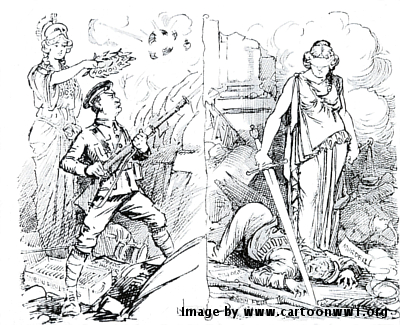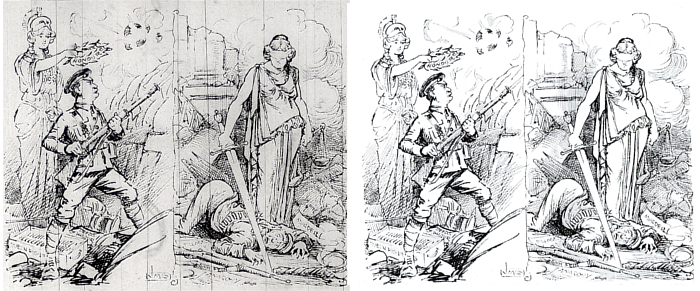Cartooning the First World War
Posted on 20 November 2014
Cartooning the First World War
 By Rhianydd Biebrach, Project Officer for Cartooning the First World War at Cardiff University.
By Rhianydd Biebrach, Project Officer for Cartooning the First World War at Cardiff University.
This article is part of our series: a day in the software life, in which we ask researchers from all disciplines to discuss the tools that make their research possible.
Cartoons are probably not the most obvious source material for the history of the First World War, but in the approximately 1,350 political cartoons drawn by Joseph Morewood Staniforth that appeared in The Western Mail and the News of the World throughout the conflict, we have a fascinating record of how those events were consumed daily at the nation’s breakfast tables.
This chronicle of the war is replete with clever caricatures of individuals such as Herbert Henry Asquith, David Lloyd George and the Kaiser, as well as Britannia, John Bull, and Staniforth’s own invention, the stout and matronly Dame Wales, in her traditional Welsh costume.
Up until now the majority of Staniforth’s cartoons have only been available to view on microfilm. However, the Heritage Lottery Funded Cartooning the First World War Project, led by Professor Chris Williams, head of Cardiff University’s School of History, Archaeology and Religion, is digitising the entire wartime collection, and those from the start of the war up to mid-1916 can now be accessed.
Most of the cartoons are smudged and dirty due to the deterioration of the original newspaper, and a large number are heavily scratched, leaving columns of black lines running vertically across the image. These are not only unsightly, but in many cases they mar the legibility of the cartoon itself and so each one has to go through a cleaning process using Corel PHOTO-PAINT x5 or Adobe Photoshop Elements, carried out by myself, a non-IT specialist, and a project volunteer. Here follow some before and after examples:

"The Sons of Erin", Western Mail, 3 May 1916, before and after restoration. Image by www.cartoonww1.org
Staniforth’s drawings were created using pen and ink. This medium allowed him to produce elegant, tightly crafted, black and white images. There is often a fair amount of white space, while shadows and darker areas were created using a series of closely packed diagonal, or cross-hatched lines. It is these which create the greatest problems when cleaning. It is not always clear which straight black lines are intentional, and therefore to be left alone, and which are scratches, and therefore to be taken out).
When the offending line has been identified it can take several minutes of painstaking work to fully clear it from the cross-hatching without damaging the integrity of the original pen work. In some cases the scratches and smudges overlay a background which has itself become discoloured. Cleaning them off then results in a white mark on an off-white ground, thus exchanging one form of blemish for another.
Several issues have been raised by this cleaning process. How do we balance the desirability of obtaining completely clean images against the time constraints imposed by the project’s funding period? It can take several hours of close work to clean up some of the worst examples to a publishable standard and this is not a sustainable level of output. Pristine images that recreate the level of clarity of the originals would be the ideal outcome in many ways. The website is intended for use primarily by the general public, including schoolchildren, and to present them with anything less than a clear image could be seen as introducing an unnecessary level of complication to their interpretation of the cartoon’s message.
On the other hand, historians are rarely fortunate enough to be confronted with primary source material that entirely retains its original appearance. Faded ink, water or other forms of damage, defacement and partial survival are merely a few of the hazards encountered by researchers. Given this, is it realistic, or even desirable, to strip away the evidence left by a century’s worth of use?
Such questions are not easy to answer, yet for the purposes of this particular project the software has made it possible to restore the clarity of the cartoons for the current generation of readers.
